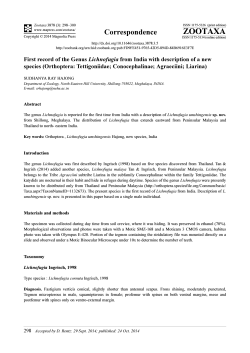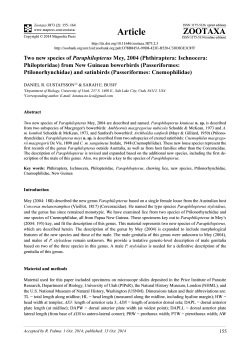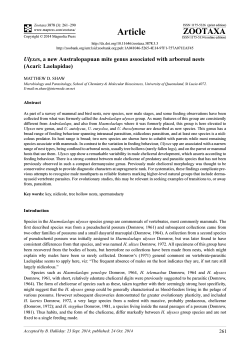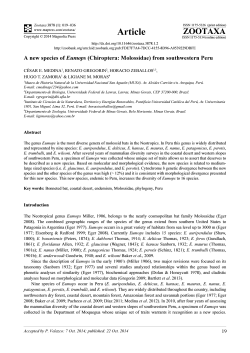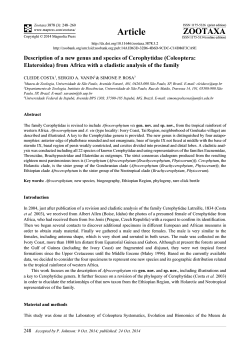
Article ZOOTAXA
Zootaxa 3881 (3): 237–257 www.mapress.com /zootaxa / Copyright © 2014 Magnolia Press Article ISSN 1175-5326 (print edition) ZOOTAXA ISSN 1175-5334 (online edition) http://dx.doi.org/10.11646/zootaxa.3881.3.3 http://zoobank.org/urn:lsid:zoobank.org:pub:4B7B9770-424F-45A5-8244-67781C74728F A new Australian genus and five new species of Rogadinae (Hymenoptera: Braconidae), one reared as a gregarious endoparasitoid of an unidentified limacodid (Lepidoptera) DONALD L. J. QUICKE1,5, MARK R. SHAW2, CORNELIS VAN ACHTERBERG3, KEITH P. BLAND2, BUNTIKA A. BUTCHER1, RICHARD LYSZKOWSKI2 & Y. MILES ZHANG4 1 Department of Biology, Faculty of Science, Chulalongkorn University, BKK 10330, Thailand. E-mail: d.quicke@email.com Department of Natural Sciences, National Museums of Scotland, Edinburgh EH1 IJF, UK 3 Afdeling Terrestrische Zoologie, Naturalis Biodiversity Center, Postbus 9517, 2300 RA Leiden, The Netherlands 4 Department of Entomology, 213C Animal Science Building, University of Manitoba, Winnipeg, Manitoba R3T 2N2, Canada 5 Corresponding author. E-mail: d.quicke@email.com 2 Abstract Teresirogas Quicke & Shaw gen. nov. (type species T. australicolorus Quicke & Shaw sp. nov.) is described and illustrated, based on a series recently reared gregariously from a cocooned mummy of an unidentified species of Limacodidae collected under loose Eucalyptus bark in New South Wales, Australia. Older reared and unreared congeneric specimens represent four additional species, T. billbrysoni Quicke & van Achterberg sp. nov., T. nolandi Quicke & Butcher sp. nov., T. prestonae Quicke & van Achterberg sp. nov., and T. williamsi Quicke & van Achterberg sp. nov., which are also described and illustrated. Three of these additional species have also been reared from Limacodidae cocoons on Eucalyptus, with one, perhaps erroneous, record suggesting a saturniid host. Molecular analysis confirms the placement of the new type species of Teresirogas in the tribe Rogadini, as inferred initially from the claws with pointed basal lobe and host relationships of some of the species, but one species has the claw character poorly developed which had made its affinities uncertain before the more recently reared and sequenceable material became available. Key words: Hymenoptera, Braconidae, new genus, new species Introduction The first and third authors (DQ & CvA) have been aware for some time of an undescribed Australian genus probably belonging to the Rogadinae mostly from old specimens in the Natural History Museum, London, the Australian Museum, Sydney and the Australian National Insect Collection, Canberra. However, its relationships were not easily discerned. Its lack of a prepectal carina, the entirely smooth and undifferentiated mid-basal area on the 2nd metasomal tergite, and the greatly reduced occipital carina (broadly absent dorsally and ventrally) would allow it to key to the Opiinae in several identification works (e.g. van Achterberg 1993, Wharton et al. 1997). If it was a member of the Rogadinae, as its general Gestalt suggested, variation in an important morphological character, the presence/absence of a pointed basal lobe on the claws, and also of the sometimes greatly swollen male maxillary palp segments, again made assessment of its affinities difficult. Fortunately, the fourth author (KPB) recently collected a mummified limacodid prepupa in its cocoon under loose Eucalyptus bark which, in addition to revealing the host group, both unequivocally showed that the new genus (or at least its type species) was gregarious and provided fresh material for molecular analysis. Mummification of lepidopteran host caterpillars or prepupae is a characteristic of the Rogadinae, some of which are known to be gregarious, whereas opiines are exclusively parasitoids of Diptera and—as far as is known—invariably solitary. Preliminary BLAST searches with the DNA sequence data (28S rDNA and the barcoding region of cytochrome oxidase 1) obtained from T. australicolorus sp. nov., confirm that it is indeed a member of the Rogadinae, and molecular analyses presented here show that it belongs to the tribe Rogadini with 100% Bayesian support. Accepted by J. Jennings: 14 Oct. 2014; published: 5 Nov. 2014 237 species is typically tricoloured: head and more or less mesosoma orange or brownish yellow, basal half of metasoma ivory or white and its apical half black. The colour of the mesosoma is variable, even within species (e.g. T. billbrysoni sp. nov.). Acknowledgements We are grateful to Barbara Sharanowski for help in arranging sequencing analysis, and to the Animal Systematic Research Unit and the Integrated Ecology Lab, Department of Biology, Faculty of Science, Chulalongkorn University for allowing us to use their Cell^D imaging facility. We would like to thank Chulalongkorn University Centenary Academic Development Project for support. References Biomatters (2011) Geneious Version 5.4.6. Available from: http://www.geneious.com/ (accessed 21 October 2014) Chen, X. & He, J. (1997) Revision of the subfamily Rogadinae (Hymenoptera: Braconidae) from China. Zoologische Verhandelingen, Leiden, 308, 1–187. Folmer, O., Black, M., Hoeh, W., Lutz, R. & Vrijenhoek, R. (1994) DNA primers for amplification of mitochondrial cytochrome c oxidase subunit I from diverse metazoan invertebrates. Molecular Marine Biology and Biotechnology, 3, 294–299. Gillespie, J.J., Yoder, M.J. & Wharton, R.A. (2005) Predicted secondary structure for 28S and 18S rRNA from Ichneumonoidea (Insecta: Hymenoptera: Apocrita): impact on sequence alignment and phylogeny estimation. Journal of Molecular Evolution, 61, 114–137. http://dx.doi.org/10.1007/s00239-004-0246-x Quicke, D.L.J. (1995) Batotheca (Hymenoptera: Braconidae) new to Australia. Australian Entomologist, 22, 17–18. Quicke, D.L.J. (2014) Biology, Systematics, Evolution and Ecology of Braconid and Ichneumonid Parasitoid Wasps, 688 pp. [Wiley Blackwell, Chichester, UK] Quicke, D.L.J. & Areekul Butcher, B. (2011) Two new genera of Rogadinae (Insecta: Hymenoptera: Braconidae) from Thailand. Journal of Hymenoptera Research, 23, 23–34. http://dx.doi.org/10.3897/jhr.23.1659 Quicke, D.L.J. & Shaw, M.R. (2005) First host record for the rogadine genus Pholichora van Achterberg (Hymenoptera: Braconidae) with description of a new species and notes on convergent wing venation features. Journal of Natural History, 39, 531–537. http://dx.doi.org/10.1080/00222930410001708678 Quicke, D.L.J., Austin, A.D. & Chishti, M.J.K. (1998) Revision of the Australasian species of Yelicones (Hymenoptera: Braconidae: Rogadinae). Invertebrate Taxonomy, 12, 897–928. http://dx.doi.org/10.1071/it97030 Quicke, D.L.J., Smith, M.A., van Achterberg, C., Miller, S.E. & Hrcek, J. (2012) A new genus and three new species of parasitoid wasp from Papua New Guinea and redescription of Trigonophatnus Cameron (Hymenoptera, Braconidae, Rogadinae). Journal of Natural History, 46, 1369–1385. http://dx.doi.org/10.1080/00222933.2012.658585 Ronquist, F., Teslenko, M., van der Mark, P., Ayres, D.L., Darling, A., Höhna, S., Larget, B., Liu, L., Suchard, M.A. & Huelsenbeck, J.P. (2012) MrBayes 3.2: efficient Bayesian phylogenetic inference and model choice across a large model space. Systematic Biology, 61, 539–542. http://dx.doi.org/10.1093/sysbio/sys029 Sharanowski, B.J., Dowling, A.P.G. & Sharkey, M.J. (2011) Molecular phylogenetics of Braconidae (Hymenoptera: Ichneumonoidea), based on multiple nuclear genes, and implications for classification. Systematic Entomology, 36, 549–572. http://dx.doi.org/10.1111/j.1365-3113.2011.00580.x Sharkey, M.J. & Wharton, R.A. (1997) Morphology & terminology. In: Wharton, R.A., Marsh, P.M. & Sharkey, M.J. (Eds.), Identification Manual to the New World Genera of Braconidae. Vol. 1. Special Publication of the International Society of Hymenopterists, pp. 19–37. van Achterberg, C. (1988) Revision of the subfamily Blacinae Foerster (Hymenoptera: Braconidae). Zoologische Verhandelingen, Leiden, 249, 1–324. van Achterberg, C. (1991) Revision of the genera of the Afrotropical and W. Palaearctical Rogadinae Foerster (Hymenoptera: Braconidae). Zoologische Verhandelingen, Leiden, 273, 1–102. van Achterberg, C. (1993) Illustrated key to the subfamilies of the Braconidae (Hymenoptera: Ichneumonoidea). Zoologisches Verhandelingen, Leiden, 283, 1–189. van Achterberg, C. (2007) Revision of the genus Spinaria Brullé (Hymenoptera: Braconidae: Rogadinae), with keys to genera 254 · Zootaxa 3881 (3) © 2014 Magnolia Press QUICKE ET AL. and species of the subtribe Spinariina van Achterberg. Zoologische Mededelingen, Leiden, 81, 11–83. Wharton, R.A., Marsh, P.M. & Sharkey, M.J. (Eds.), (1997) Manual of the New World genera of the family Braconidae (Hymenoptera). Vol. 1. Special Publication of the International Society of Hymenopterists, 439 pp. Yu, D.S., van Achterberg, C. & Horstmann, K. (2014) Taxapad 2014, Ichneumonoidea 2011, Ottawa, Canada. Database on flash-drive. Available from: www.taxapad.com (Accessed 16 October 2014) Zaldivar-Riverón, A., Belokobylskij, S.A., León-Regagnon, V., Briceno, R. & Quicke, D.L.J. (2008) Molecular phylogeny and historical biogeography of the cosmopolitan parasitic wasp subfamily Doryctinae (Hymenoptera: Braconidae). Invertebrate Systematics, 22, 345–363. http://dx.doi.org/10.1071/is07028 Zaldivar-Riverón, A., Shaw, M.R., Saez, A.G., Mori, M., Belokobylskij, S.A., Shaw, S.R. & Quicke, D.L.J. (2009) Evolution of the parasitic wasp subfamily Rogadinae (Braconidae): phylogeny and evolution of lepidopteran host ranges and mummy characteristics. BMC Evolutionary Biology, 8, 329–329. http://dx.doi.org/10.1186/1471-2148-8-329 Zaldívar-Riverón, A., Rodríguez-Jiménez, A., Sarmiento, C.E., Pedraza-Lara, C. & López-Estrada, E.K. (2013) Phylogenetic relationships and description of Bolivar, a new genus of Neotropical doryctine wasps (Hymenoptera: Braconidae). Invertebrate Systematics, 27, 673–688. APPENDIX 1. Material included in molecular analyses. Genbank accessions numbers starting with KM are newly generated for this study. Subfamily/tribe Species Betylobraconinae Mesocentrus sp. Doryctinae Dendrosoter protuberans Hormiinae Lysiterminae Provenance Australia Rhyssalinae COI KM067175 JF963534 EF645736 EF645775 USA GQ374709 GQ374627 Megaloproctus sp. Colombia AY935466 AY935393 Hormius sp. Madagascar AY935455 AY935385 Parahormius sp. Cameroun AY935456 AY935386 Acanthormius sp. 1 Madagascar AJ302883 AY935381 Acanthormius sp. 2 Thailand - KM067236 Katytermus sp. Japan EU854406 EU979624 Lysitermus sp. 1 Uganda EU854405 KM067238 Lysitermus sp. 2 Nigeria KM067177 JF963503 Pentatermus sp. 1 Madagascar KM067178 FN662435 Pentatermus sp. 2 Madagascar KM078032 JF963713 Pentatermus sp. 3 Thailand KM067179 KM067254 Pentatermus sp. 4 Nigeria KM067212 JF963501 Pentatermus sp. 5 Benin AY935453 AY935383 EU854407 - Tetratermus sp. 1 Uganda AY935452 AY935382 Tetratermus sp. 2 Nigeria KM067180 ? JF963501 Notiopambolus depressicauda Australia AY935459 AY935389 - JQ268750 AY935450 AY935377 Pambolus rastafari Rhysipolinae 28S Doryctes erythromelas Platyrmus maichaui Pambolinae Genbank accession number Pseudorhysipolis sp. Costa Rica Rhysipolis temporalis Russia AY935449 AY935376 Rhysipolis sp. 1 - GQ374708 GQ374626 Rhysipolis sp. 2 Thailand - KM067237 ?Rhysipolis Chile KM078031 KM078033 Oncophanes sp. UK AY935481 AY935407 ......continued on the next page A NEW AUSTRALIAN BRACONID WASP GENUS Zootaxa 3881 (3) © 2014 Magnolia Press · 255
© Copyright 2025







